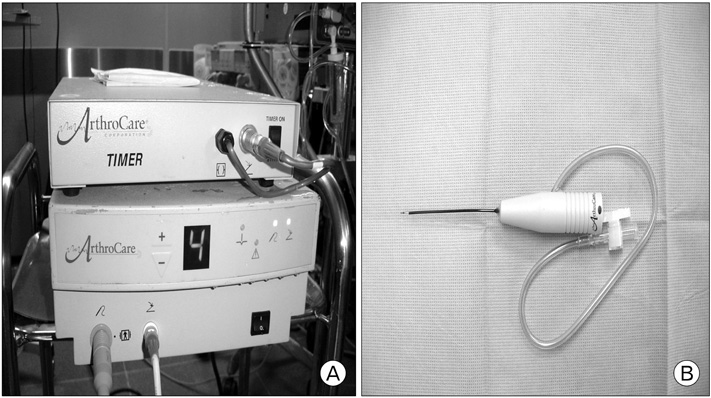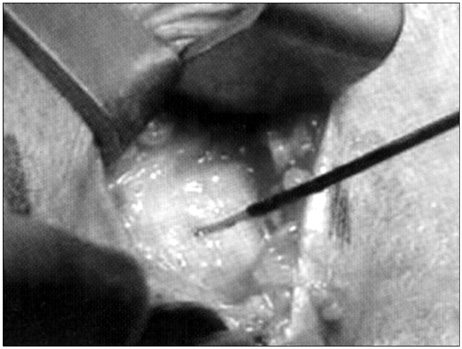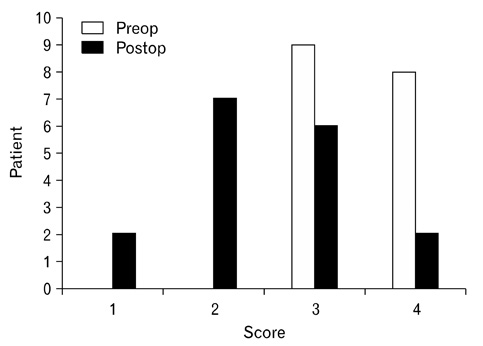Korean J Sports Med.
2017 Dec;35(3):155-161. 10.5763/kjsm.2017.35.3.155.
Preliminary Clinical Results of Topaz Microdebridement Procedure in Lateral Epicondylitis Patients
- Affiliations
-
- 1Department of Orthopedic Surgery, Samsung Medical Center, Sungkyunkwan University School of Medicine, Seoul, Korea. shoulder.yoo@samsung.com
- 2Department of Orthopedic Surgery, Soonchunhyang University Bucheon Hospital, Soonchunhyang University College of Medicine, Bucheon, Korea.
- KMID: 2397810
- DOI: http://doi.org/10.5763/kjsm.2017.35.3.155
Abstract
- The purpose of this study is to clinically evaluate and report the effectiveness of radiofrequency microdebrider (Topaz, ArthroCare) treatment in lateral epicondylitis patients. From March to July 2003, 15 patients of 17 elbows were prospectively followed. Candidate for the treatment were lateral epicondylitis patients who had symptom more than 6 month and failed to respond to conservative treatment, including medication (non-steroidal anti-inflammatory drugs), external gel or patch, and steroid injections. All patient who scored greater than grade 3 (fair) on the Self-administered Roles and Maudsley Pain (SRMP) score were selected for the procedure. All procedure was done using local anesthesia and ArthroCare microdebrider by a single surgeon. Postoperative assessments were done on postoperative period 12 month of two previous subjective scores and a simple functional assessment asking better, same, or worst function after the procedure. Mean age of the patients was 45 years old. Mean symptom duration before the procedure was 22.6 months. After the procedure, the mean Pain Visual Analogue Scale improved from 7.3 (range, 5-9; standard deviation [SD], 1.2) preoperatively to 3.7 (range, 0-7; SD, 2.1) postoperatively (p< 0.001). After the procedure, five elbows showed no rating improvement, in seven elbows 1 level improvement, in four elbows 2 level improvement, and in one elbow 3 level improvement. Overall, 71% (12/17) showed improvement after the procedure according to the SRMP score rating. Although 29% (5/17) of the elbow showed no improvement on SRMP score, among them five elbows were still rated decrease in Pain Visual Analogue Scale.
MeSH Terms
Figure
Reference
-
1. Nirschl RP, Pettrone FA. Tennis elbo: the surgical treatment of lateral epicondylitis. J Bone Joint Surg Am. 1979; 61:832–839.2. Goldie I. Epicondylitis lateralis humeri (epicondylalgia or tennis elbow): a pathogenetical study. Acta Chir Scand Suppl. 1964; 57:Suppl 339. 1+.3. Almquist EE, Necking L, Bach AW. Epicondylar resection with anconeus muscle transfer for chronic lateral epicondylitis. J Hand Surg Am. 1998; 23:723–731.4. Coonrad RW, Hooper WR. Tennis elbow: its course, natural history, conservative and surgical management. J Bone Joint Surg Am. 1973; 55:1177–1182.5. Baumgard SH, Schwartz DR. Percutaneous release of the epicondylar muscles for humeral epicondylitis. Am J Sports Med. 1982; 10:233–236.6. Owens BD, Murphy KP, Kuklo TR. Arthroscopic release for lateral epicondylitis. Arthroscopy. 2001; 17:582–587.7. Nirschl RP, Ashman ES. Tennis elbow tendinosis (epicondylitis). Instr Course Lect. 2004; 53:587–598.8. Labelle H, Guibert R, Joncas J, Newman N, Fallaha M, Rivard CH. Lack of scientific evidence for the treatment of lateral epicondylitis of the elbow: an attempted meta-analysis. J Bone Joint Surg Br. 1992; 74:646–651.9. Roles NC, Maudsley RH. Radial tunnel syndrome: resistant tennis elbow as a nerve entrapment. J Bone Joint Surg Br. 1972; 54:499–508.10. Stalder KR, Woloszko J, Brown IG, Smith CD. Repetitive plasma discharges in saline solutions. Appl Phys Lett. 2002; 79:4503–4505.11. Grekin RC, Tope WD, Yarborough JM Jr, et al. Electrosurgical facial resurfacing: a prospective multicenter study of efficacy and safety. Arch Dermatol. 2000; 136:1309–1316.12. Bortnick DP. Plastic Surgery Educational Foundation DATA Committee. Coblation: an emerging technology and new technique for soft-tissue surgery. Plast Reconstr Surg. 2001; 107:614–615.13. Hall DJ, Littlefield PD, Birkmire-Peters DP, Holtel MR. Radiofrequency ablation versus electrocautery in tonsillectomy. Otolaryngol Head Neck Surg. 2004; 130:300–305.14. Nirschl RP. Tennis elbow. Orthop Clin North Am. 1973; 4:787–800.15. Edwards SG, Calandruccio JH. Autologous blood injections for refractory lateral epicondylitis. J Hand Surg Am. 2003; 28:272–278.16. Wadsworth TG. Lateral epicondylitis (tennis elbow). Lancet. 1972; 1:959–960.17. Hildebrand KA, Woo SL, Smith DW, et al. The effects of platelet-derived growth factor-BB on healing of the rabbit medial collateral ligament: an in vivo study. Am J Sports Med. 1998; 26:549–554.18. Merolla G, Dellabiancia F, Ricci A, et al. Arthroscopic debridement versus platelet-rich plasma injection: a prospective, randomized, comparative study of chronic lateral epicondylitis with a nearly 2-year follow-up. Arthroscopy. 2017; 33:1320–1329.19. Unlu MC, Kivrak A, Kayaalp ME, Birsel O, Akgun I. Peritendinous injection of platelet-rich plasma to treat tendinopathy: a retrospective review. Acta Orthop Traumatol Turc. 2017; 11. 03. [Epub]. DOI: 10.1016/j.aott.2017.10.003.20. Haake M, Thon A, Bette M. Absence of spinal response to extracorporeal shock waves on the endogenous opioid systems in the rat. Ultrasound Med Biol. 2001; 27:279–284.21. Wang CJ, Chen HS. Shock wave therapy for patients with lateral epicondylitis of the elbow: a one- to two-year followup study. Am J Sports Med. 2002; 30:422–425.22. Speed CA, Nichols D, Richards C, et al. Extracorporeal shock wave therapy for lateral epicondylitis: a double blind randomised controlled trial. J Orthop Res. 2002; 20:895–898.23. Haake M, Konig IR, Decker T, et al. Extracorporeal shock wave therapy in the treatment of lateral epicondylitis: a randomized multicenter trial. J Bone Joint Surg Am. 2002; 84:1982–1991.24. Koksal I, Guler O, Mahirogullar M, Mutlu S, Cakmak S, Aksahin E. Comparison of extracorporeal shock wave therapy in acute and chronic lateral epicondylitis. Acta Orthop Traumatol Turc. 2015; 49:465–470.25. Pierce TP, Issa K, Gilbert BT, et al. A systematic review of tennis elbow surgery: open versus arthroscopic versus percutaneous release of the common extensor origin. Arthroscopy. 2017; 33:1260–1268.e2.26. Kantor B, McKenna CJ, Caccitolo JA, et al. Transmyocardial and percutaneous myocardial revascularization: current and future role in the treatment of coronary artery disease. Mayo Clin Proc. 1999; 74:585–592.27. Meknas K, Al Hassoni TN, Odden-Miland A, Castillejo M, Kartus J. Medium-term results after treatment of recalcitrant lateral epicondylitis: a prospective, randomized study comparing open release and radiofrequency microtenotomy. Orthop J Sports Med. 2013; 1:2325967113505433.28. Pomerantz ML. Complications of lateral epicondylar release. Orthop Clin North Am. 2016; 47:445–469.29. Tasto JP, Richmond JM, Cummings JR, Hardesty R, Amiel D. Radiofrequency microtenotomy for elbow epicondylitis: midterm results. Am J Orthop (Belle Mead NJ). 2016; 45:29–33.30. Meknas K. Re: radiofrequency microtenotomy: a promising method for treatment of recalcitrant lateral epicondylitis. Am J Sports Med. 2008; 36:e2–e3.
- Full Text Links
- Actions
-
Cited
- CITED
-
- Close
- Share
- Similar articles
-
- Suggestions for Effective Extracorporeal Shock Wave Treatment Methods for Lateral Epicondylitis
- Treatment of Recalcitrant Medial and Lateral Epicondylitis with Autologous Platelet Rich Plasma; Preliminary Report
- Ultrasonographic Findings of Common Pathologic Conditions of the Elbow and Injections Focusing on Lateral Epicondylitis
- Surgical Treatment of Intractable Lateral Epicondylitis with Nirschl Procedure
- Lateral Epicondylitis: Current Concept





